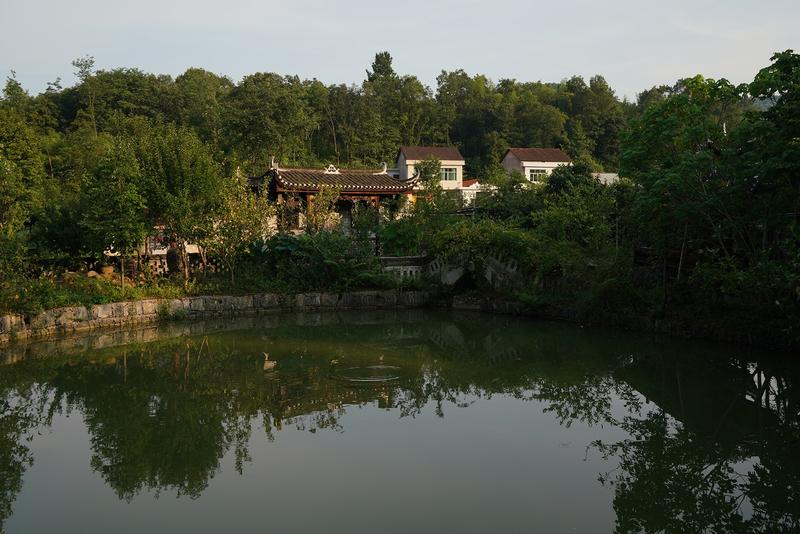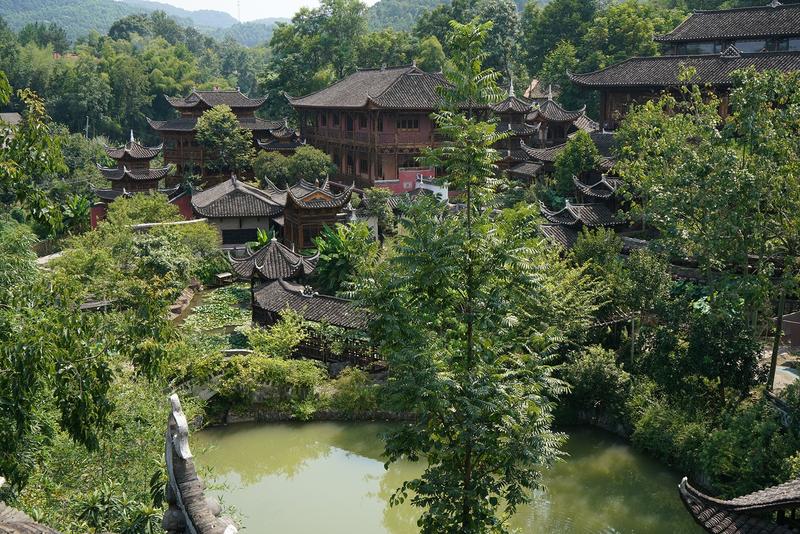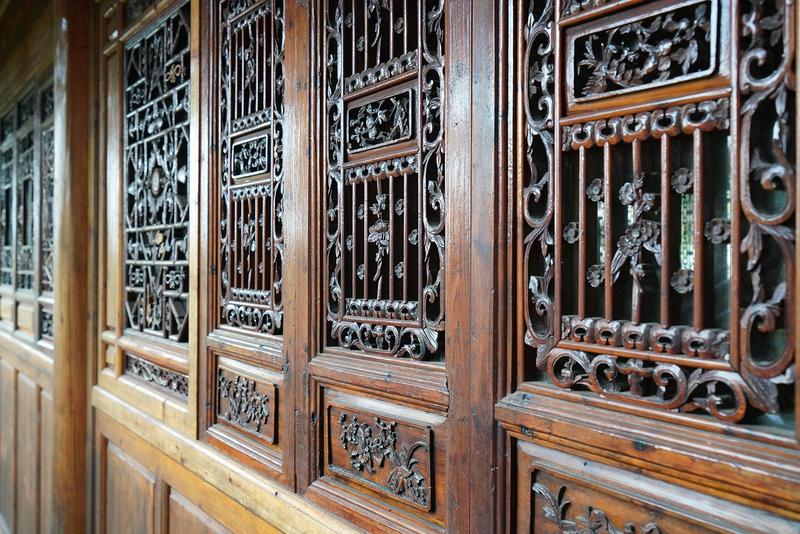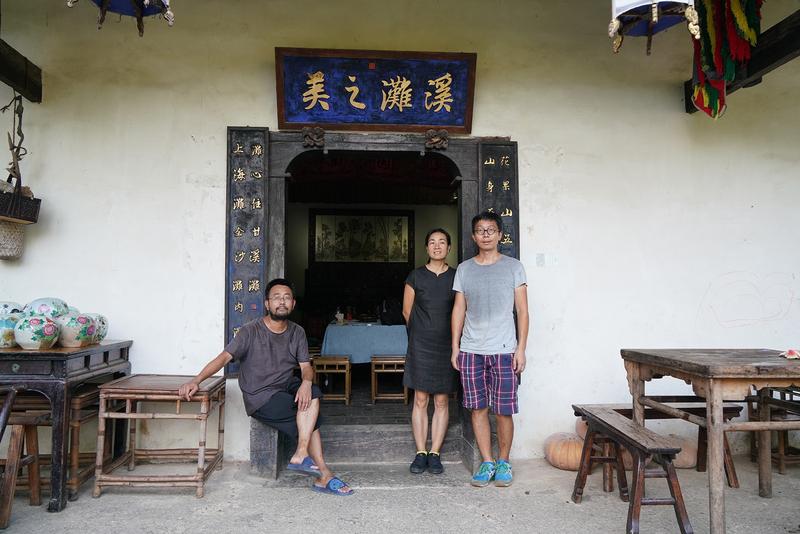An art complex has been built on the site of a family residence, using architectural material from another era, report Xu Lin in Changde and Zhu Youfang in Changsha.
 The Gallery Above the Stream in Lixian county, Changde city, Hunan province, was built using fittings, including wooden windows with exquisite carvings, that date from another era. (XU LIN / CHINA DAILY)
The Gallery Above the Stream in Lixian county, Changde city, Hunan province, was built using fittings, including wooden windows with exquisite carvings, that date from another era. (XU LIN / CHINA DAILY)
At the foot of a mountain is a complex, which has more than a dozen traditional-style buildings, with pavilions and corridors, and small bridges and a pond. Unlike well-preserved ancient courtyards that are often frequented by visitors, it has a far more recent timeline of construction.
However, the complex was nonetheless built using exquisite carved fittings, including wooden doors and windows, that came from a far more distant era.
It has exhibition rooms, with antique paintings and sculptures that are mainly about the culture in the south of the Yangtze River such as Hunan, Fujian, Guizhou and Sichuan provinces. The Gallery Above the Stream, also known as the Lei Family Courtyard, is located in Ganxitan town, Lixian county, Changde city, Central China's Hunan province. On an area of about 0.67 hectares, the secluded gallery is more than 60 kilometers from downtown Lixian and is open to visitors with an entrance fee of 50 yuan ($6.95).
"The courtyard is like an ancient landscape painting, inviting guests to walk in, stroll around the terraces, rest in the pavilions, and eventually find inner tranquility," says 44-year-old Lei Ming, who lives in the family home there.
Lei first studied fine arts in a Changde university and furthered his painting skills at the Central Academy of Fine Arts in Beijing.
Amid blue mountains and green waters, the complex is his own Arcadia — Lei is the chief designer, material purchaser and overseer, paying attention to all construction details.
 The gallery's exhibition rooms showcase Lei Ming's collections, such as antique paintings and sculptures, that are indicative of the culture south of the Yangtze River. (XU LIN / CHINA DAILY)
The gallery's exhibition rooms showcase Lei Ming's collections, such as antique paintings and sculptures, that are indicative of the culture south of the Yangtze River. (XU LIN / CHINA DAILY)
Cultural inheritance
Several years ago, Lei Ming, along with his younger brother, Lei Liang, and sister-in-law, Qin Xiang, came to a major decision to abandon their promising careers in Beijing to construct the courtyard in the hometown of the Lei family. The brothers closed their antique shop in Beijing, and Qin quit her civil service position and sold her apartment and car in the capital to expand the Ganxitan complex. Nine members of the Lei family now live in the mansion, including the brothers' parents, uncle and the three children of Lei Liang.
China's rural vitalization strategy involves developing farming culture and making local culture flourish, aiming to build a new socialist countryside that is beautiful, prosperous and harmonious. The courtyard is undoubtedly a remarkable example of a cultural inheritance.
"Many guests wonder about the architecture of the complex. I tell them that there is no fixed style and that I constructed the buildings, based on my understanding of ancient landscape paintings. It's the outcome of my aesthetic approach and regional culture," says Lei Ming.
"The traditional architectural fittings are old, including the carved wooden festoons. All stone sculptures, ornaments and even the water tanks in the yard are old items, to create the atmosphere of quaint charm."
He says he followed the traditional philosophy of "Tao follows nature" and "human beings are an integral part of nature" to build the high and low-rise buildings in accordance with the terrain.
"I gradually realize that the essence of traditional Chinese culture is to teach people to be charitable and live a peaceful life."
He purchased the old architectural fittings, hired skilled craftspeople to carefully repair them and install them in the buildings.
"It's difficult and expensive for modern craftspeople to make a genuine copy of such delicate handiworks, which are treasures of traditional Chinese handicraft," he says.
A wooden "wind-and-rain bridge" — consisting of the bridge, a tower and a pavilion — is common in southern China. The first construction in the courtyard was that of such a bridge, modeled on the village's pretty bridge built in the Ming Dynasty (1368-1644), which had been destroyed and replaced with a cement one.
"When I was a kid, I often walked on the wooden bridge in the village, so I built a small one in the traditional method due to nostalgia," he says.
 The elegant carved patterns on old wooden doors are ubiquitous in the courtyard. (XU LIN / CHINA DAILY)
The elegant carved patterns on old wooden doors are ubiquitous in the courtyard. (XU LIN / CHINA DAILY)
Folk tales
It's not easy to make an inventory of all his collections, because he's still buying antique pieces, some of which are in the storehouse to be repaired. Lei Ming is familiar with the legends and folk stories about the carved patterns on wooden doors and introduces them to guests when he meets them in the corridors.
"I find pleasure in what I'm doing now, such as repairing an antique piece and decorating the courtyard," he says.
When speaking about an ancient window in the house, he says it showcases the "eight immortals" in Chinese mythology, "mounting the clouds and riding the mist".
Each room is decorated with such treasures. His favorite exhibition hall displays about 400 Nuo masks of various expressions, amiable or ferocious, which are mainly from some time during the Ming (1368-1644) and Qing (1644-1911) dynasties.
He has been influenced by local folk art and customs since his childhood, especially Nuo Opera, which is an intangible cultural heritage. It is a popular folk art form that aims to "drive away devils and diseases, and pray for blessings".
The Nuo folk religion used to be popular in many parts of the country. Performers would wear a Nuo mask to play a figure from Chinese mythology who was worshiped by locals.
"These masks also showcase the culture of the ancient farming society in China, telling various folk stories. One mask looks like a foreign face, indicating China's communication with other countries then," he says.
"While the Nuo masks from Hunan are in primitive style, often with a sad expression, those from Sichuan have exaggerated expressions, with exquisite details."
 Lei Ming along with his younger brother, Lei Liang and sister-in-law Qin Xiang made a life-changing decision to quit their promising careers in Beijing to construct the elegant family courtyard. (XU LIN / CHINA DAILY)
Lei Ming along with his younger brother, Lei Liang and sister-in-law Qin Xiang made a life-changing decision to quit their promising careers in Beijing to construct the elegant family courtyard. (XU LIN / CHINA DAILY)
Dilemma, decision
In 2008, Lei Ming's mother wanted the old house in their hometown to be taken down and rebuilt in somewhat of a European style. The son says he instead decided to repair the house for his parents to live out their retirement after they wanted to move from Beijing.
At first, he had a rough plan — he constructed a building, two pavilions and a bridge in the first year, but in the next year, he had more ideas. He had no notion then that it would be such a massive project, or a "sweet burden", for the whole family.
By 2019, the courtyard had developed to its current scale, and in 2021, four small bridges were built near the courtyard, to make the surroundings "more harmonious".
Lei Ming temporarily suspended the expansion of the complex due to the COVID-19 pandemic. He had hired about 40 craftspeople earlier for the repairs but kept only a few later.
"I want to share the beauty with others, display my precious collection, and maintain the courtyard well. But it's strenuous work, and my family members try their best to help," he says.
There is a division of labor for all the adults in the Lei family. The elderly are in charge of planting vegetables, raising livestock and cooking, while the Lei brothers and Qin are responsible for all other important issues of the complex. Currently, they organize cultural events for companies and receive individual guests, to cover the water and electricity costs and salaries of the craftspeople working there.
"We want to concentrate our energy on improving the courtyard itself. We don't do much publicity but gain visitors by word-of-mouth, especially among those interested in traditional culture," Lei Ming says.
Art institutions sent students to draw in the courtyard and visitors from neighboring regions drive for several hours to view the complex, sample the food made by the Lei brothers' parents and uncle, and stay overnight.
The story of the Lei brothers, and Qin, is a bit unusual for urban dwellers — three well-educated people quit their careers in a big city in their 30s to devote time to a family courtyard in a small county and lead an idyllic life. Unlike small families in big cities, the Lei family's lifestyle was not uncommon in rural areas of the country earlier. The family put all its savings into the courtyard and is about 5 million yuan in debt, of which 2 million is a low-interest loan from the local government.
Qin, who's in charge of the courtyard's operation, recalls that soon after she sold her apartment in Beijing in 2016, its market price increased by about 2 million yuan. Qin says she comforts herself thinking that the value they've created in the courtyard is more. While she was in Beijing, Qin often spoke with people in the art world and got interested in the family's antiques. Nonetheless, it took her a long time to make the decision to return and adapt to the new environment in Ganxitan.
"I have to tackle some issues caused mainly by the urban-rural disparity. For example, our avant-garde ideas are different from others, and my eldest daughter, who returned here at the age of 6, was unaccustomed to some things in school at first," she says.
"We want to turn the courtyard into an energetic place, displaying the folk culture of the farming community," Qin says, adding that many people have encouraged them to continue the work, and she hopes to win more support from the government to improve the surrounding infrastructure, such as a parking lot.
Contact the writers at xulin@chinadaily.com.cn


